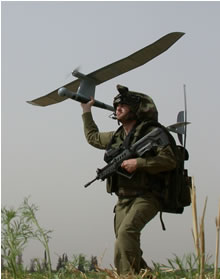In recent conflicts the use of Unmanned Aerial Vehicles (UAV) proliferated, in support of all types of combat missions. Today, UAVs are offering various services, including intelligence gathering for tactical, theater and national level, maintaining patrols on homeland security and maritime surveillance missions, providing various force protection coverage, in support of deployed forces in the West bank and Gaza, Iraq, Afghanistan and Iraq. On the strategic level, large UAVs are performing these missions with dedicated payloads. However, smaller, tactical UAVs are being developed to support tactical units with very short range “over the hill” and “around the corner” intelligence, and assist in force protection. While each mission requires a different profile and capabilities, the man portable Miniature Aerial Vehicles (MAV) are designed to provide reasonably good performance at an affordable price.
To effectively support the field troops, smaller UAVs are designed, ranging from backpackable systems to insect-sized “mesicopters”, and miniature “smart dust” sensors. They can be launched by hand, deployed by larger UAVs, or ejected from artillery or mortar projectiles, as expendable sensors. These systems are broadly designated as Miniature Aerial Vehicles (MAV). Current systems are relatively large for a “micro” designation. However, new electro-opto-mechanical integrated microSYSTEMs currently in research and development will enable these systems to be much smaller, and operate autonomously in concert, to monitor and sense the battlefield, and further than that engage and defeat a wide variety of hostile forces across the entire spectrum of conflict.
Additional parts of this article:
















